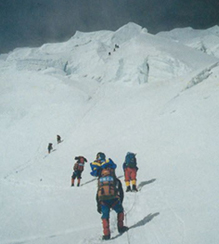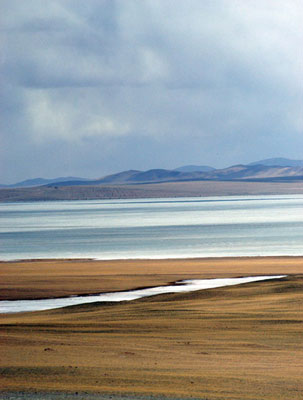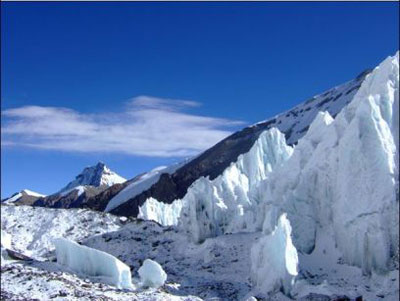As global warming continues, glacier recession on the Tibetan Plateau has quickened, triggering a series of environmental calamities.
As winter sets in, the locals on the Tibetan plateau have warily sensed the climate change unfolding before them with each passing day. Winters are not as cold as before. The warmer climate has sparked an onset of epidemic diseases, namely flu and pneumonia, which rarely occurred in the recent past.
Rongbuk River
The Rongbuk River near the Himalaya glacier has started acting capriciously regarding its unpredictable water flow. Wary Tibetan parents tell their children to keep away from it for safety reasons.
When it comes to the weather, a native woman told a reporter with the Nanfang Weekend that the water in summer is no longer as clean as before. In the past, the first three months of year were the most pleasant, but it is not the case now since the weather has become fickle. “It seems like someone has cast a warm spell,” she said, looking very worried.
For those people living along the river, glaciers are their life rafts. Some locals have reported that the melting glacier is affecting their way of life.
“For climbers, we must be able to guarantee good weather. But now, even in the best season, the weather is not as regular as before,” Yu Liangpu, a frequent visitor and Himalaya’s veteran climber said.
Yu has sensed the climate change on the Tibetan plateau. He said: “Several years ago, at the height of 5,600 meters above sea level, we could see beautiful forests in the serac regions, but now we must climb higher to view them.”
The majority of the rivers in China and some of the world’s major river systems have their headwaters high on the Tibetan plateau, making the area quite significant because it is the source of water for hundreds of millions of people.
Dubbed the “water tower of Asia”, the Tibetan plateau is home to an expanse of glaciers measuring 59,425 square kilometers. But now the glaciers are shrinking by 131 square kilometers yearly, mainly as a result of human-induced greenhouse gas emissions. An estimated one third of them will have vanished by 2050.
Liu Shiyin, a researcher with the Chinese Academy of Sciences, remarked that the warming weather would reduce any disasters caused by cold snaps but it would also increase the occurrence of drought and drought-related disasters. At the same time, precipitation changes could lead to more avalanches, storms and mountain torrents.
As an indicator of the global climate, the Tibetan plateau is vulnerable to climate changes. Its vulnerability is attributed to its cleanness, coldness and long exposure to the sun, and its unique geomorphology. The plateau embraces glaciers, frozen soil, deserts and lakes; every part is closely linked to the other.
For this year's World Environment Day, the UN designated the theme as "melting ice", echoing the accelerated rate of glacier retreat.
The locals know that glacier retreat will cause disasters such as floods and mud-rock flow.
“Because the melting rate is faster now, more icy lakes are forming than before,” Yu Liangpu said.
Icy lake on Tibetan plateau
One danger is that these newly formed lakes may send water cascading down mountainsides and trigger mud-rock flows that are potentially lethal for the villages below.
The increased water supply caused by the glacier recession will benefit local irrigation and stockbreeding. But such benefits are short-lived because the glaciers will be gone within several decades or several hundred years.
Last May, after three expeditions to Mount Qomolangma (Mount Everest) and Yellow River source, Greenpeace concluded that Mount Everest area has undergone the most dramatic climate change in all of China. This means that southern China, Nepal and northern India will face water shortages coupled with economic losses and environmental damage in the near future as the glaciers disappear.
Greenpeace has fiercely urged the whole world to cut greenhouse gas emissions to salvage the shrinking glaciers. Otherwise millions of people are doomed to a water crisis.
Currently climate change has brought about a raft of unpredictable disasters such as floods, drought and other unusual weather. Scientists have appealed for more attention and greater efforts from the scientific circle to tackle the estimated outcome.
To document the change in the country’s glaciers, China has conducted a survey on glacier resources for the second time.
The research on microorganisms living in the highland glaciers has just begun to garner attention from scientists in recent years.
Scientist Yao Tandong used evidence from the sample taken from the glaciers to suggest prudently that the microorganisms inhabiting the glaciers include viruses, germs, antinomyces, filamentous eumycetes, saccharomycetes and algae, some of which are potentially hazardous to the human being.
Rongbuk Glaciers
His student, Dr. Zhang Xinfang, confirmed his finding, and added: “We have collected and cultivated over one million germs. Based on comparative analysis, we have found that there are more varieties of germs living in the Tibetan Plateau than the Antarctic Pole. Conventionally, most germs are not harmful, but we are not sure what the consequences would be if glacier germs were activated or transmutable in warmer conditions.”
Some scientists have argued that so little is known about these ancient microorganisms that they cannot avert or prevent any potential calamity they may cause.
These microorganisms may emerge from the glaciers and then they would be spread by wind. The situation would be compounded by human activities.
“The unknown viruses are waiting for a host. Activated viruses would be a threat to the human immune system,” Zhang said anxiously.
Similar findings from similar studies from other parts of the world reinforce Zhang’s concerns.
Scientists fear that viruses and germs kept at bay for thousands of years or even longer would be unleashed from the melting ice and could ravage the human society.
(China.org.cn by He Shan, November 1, 2007)










